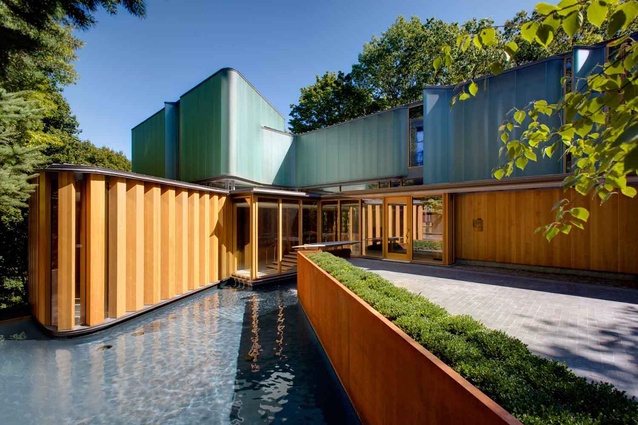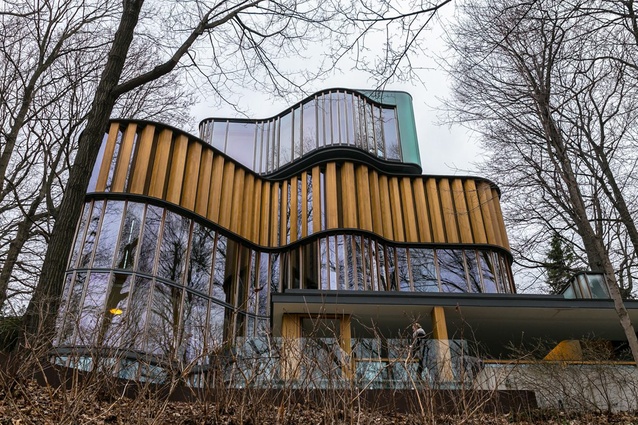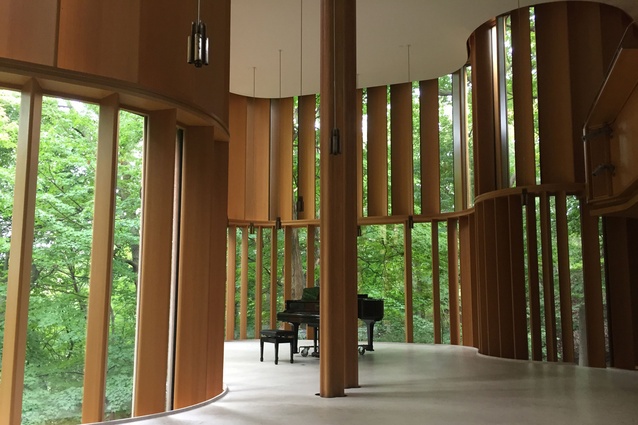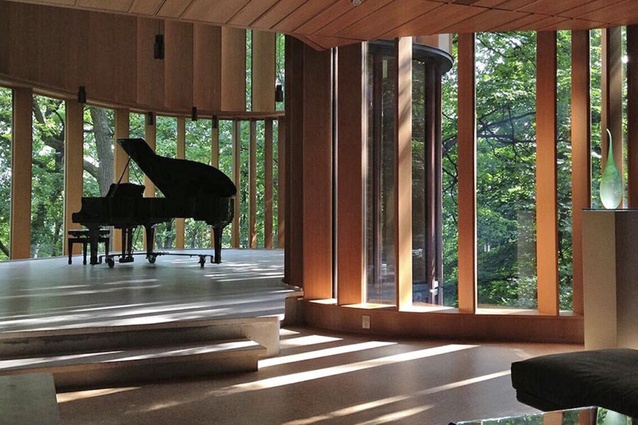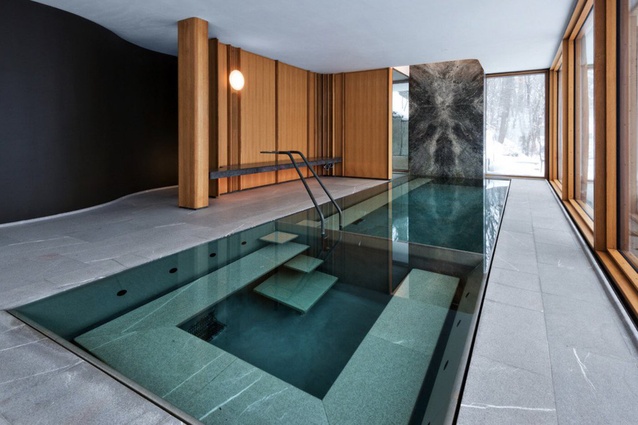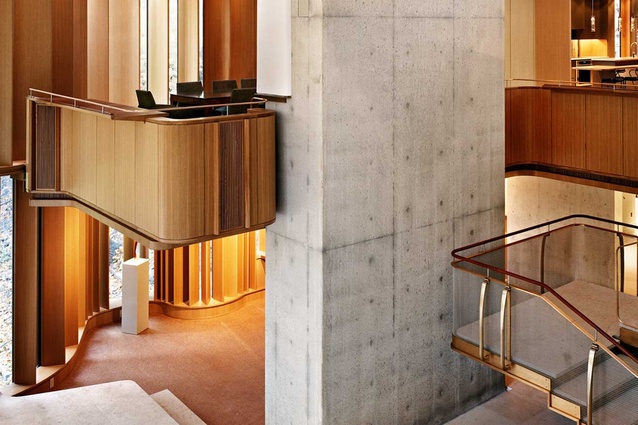The man behind the house: Integral Man
The documentary Integral Man is soon to arrive in New Zealand. It looks at an iconic house/concert hall in Toronto, Canada and James (Jim) Stewart, the man who commissioned and inspired its design. Federico Monsalve talks to the film’s director Joseph Clement.
Federico Monsalve (FM): How did you first come across James and his home and how did he come to agree to be filmed?

Joseph Clement (JC): I was working with Ken Smith, a landscape architect in New York, when Brigitte Shim, part of the architecture duo who designed Integral House, came into the office and was showing Ken photos of the house nearing completion. Ken, knowing I was from Toronto, called me up to see the photos.
At this point in my career I was beginning to feel like I wanted to expand beyond the confines of landscape and was already growing restless, but when I saw the amazing photos of the house under construction, I knew I had to do something more. Shortly after that meeting, I resigned to pursue a Masters in Fine Art at the Ontario College of Art and Design. It was here I discovered my love and passion for documentary, originally having applied to study landscape and sculptural installation works.
Just weeks after my graduation, one of my thesis advisors, Michael Prokopow, invited me to the opening reception of a retrospective on the work of architect George Baird. It was in George’s office where Brigitte received her first introduction to professional practice and was subsequently at the opening. Upon being re-introduced to Brigitte, I told her I was certain she wouldn’t remember me, but that she had changed my life. I recounted the above story from Ken’s office and she immediately said, you must come to Integral House and meet Jim Stewart.
The next week I was given a tour of the house and by the end, I knew it should be the first documentary I would make. Both Brigitte and Jim agreed and we started shooting a few months later.
FM: What was your initial interest in this story (i.e was it the architecture, the music, the mathematics, the man?)
JC: Originally it was going to be a short documentary about the house itself, but as we talked to Jim during shoots, I quickly discovered that the two, the house and Jim, were inextricably linked. Jim’s story of how he came to build the house was incredible and the story about the house and the architects would be incomplete without him.

FM: How did your landscape practice influence your treatment of the subject?
JC: The house is incredibly cinematic, which makes shooting there an incredible joy. There are no doors, so you can move from level five to level one without passing through a single door, which makes the journey through the house much like that of walking through a landscape.
Shim Sutcliffe Architects are deeply concerned about landscape and the relationship of their work to that context so the house relates to its ravine surroundings in a deeply feeling way. We were sure to focus on this relationship when filming the house, so you will see that we use quite a few dolly shots that explore the sense of movement, with the exterior landscape often being the focus and the outer wall functioning as a semi-permeable scrim.
The vertical wood fins found throughout the residence also reflect the tree trunks of the forest backdrop, further blurring this line between architecture and landscape, so we were focused on the repetition of these vertical elements during the filming. We also shot most of the film and all of the architecture shots on 35mm.
Light and its various qualities ostensibly function as a character in the film. Being a glass house in a ravine, every day the intensity, colour, location and breadth of light was different, so using 35mm to document light seemed to be a logical and necessary treatment.
FM: It is a very intimate act to let a stranger into your home to document it… was James ever cautious? Were there spaces you were not allowed in?
JC: Jim was an open book. We discussed so many issues, like his work as a gay rights activist and we discussed deeply the meaning of dying once it was discovered he was terminally ill. He was not aware of his cancer when we began shooting. Much of that information was left out of this film, which was a difficult decision, but ultimately we decided this wasn’t a biography on Jim – it was about Jim and the house and this unique relationship, not a sweeping life legacy story.
That has been one of the criticisms of the film – people want to know more about Jim. I consider that a compliment as I think often we tell too much and don’t leave room for interpretation. This film is very much about a meditative reflection, an opportunity for the audience to digest and consider what space means, what that relationship is between the human body and the space around it. It’s also an opportunity to reflect on our desires and passions and what that means to have that brought into sharp focus and, eventually, face the ultimate existential scenario.

FM: It is a very gentle, benevolent look at James. We don’t see his more irreverent, flamboyant and probably polarizing side… was this your choice or did James have a say on this?
JC: Jim had no involvement in the creation or editing of the film. He was a very hands-off subject and that was great. He was open to us shooting whatever we thought was relevant and asking any questions. Jim offered no thoughts or opinions on what we were doing with the material. His only input was to suggest events that were happening at Integral House that may be of specific interest.
He died two and a half years into this project that was a five-year endeavour so he never saw the film. At his living wake, we cut together a short 10-minute version of what we had at that time and it was screened at the event.
FM: James passions were music and mathematics; were there mathematical concepts you tried to illustrate or which you know were considered while the architects were designing this space?
We didn’t want to bring mathematics into it in a literal interpretation way. The house was designed using curves – Jim loved curves and their relationship to calculus is pretty clear, but the architects also steered clear of being literal. The focus on light in the film is actually more about an exploration of space as it changes based on the influence of light and its ability to inform the space, becoming, in a sense, a form of architecture in an intangible sense.
FM: Tell us about some of your favourite architectural moves, materials, spaces.
It was only after three years of shooting that I feel I stopped noticing new details. The house is exquisitely crafted. It’s a very unique house in that, according to Brigitte, it could most likely only have been built in Toronto. There is a huge immigrant population here, over 50 per cent of the population is not Canadian-born, so with all of those different cultures come different and highly skilled trades and craftsmen that allowed the level of detailing and the broad use of materiality to be integrated seamlessly.
That being said, the pool is really stunning. There is an amazing moment, when you are at the lowest level, deep in the ravine and at the forest floor, and you look at the pool and it reflects the sky. So, even being far removed from the highest level, you’re still connected to the sky. I think that’s a pretty beautiful move.
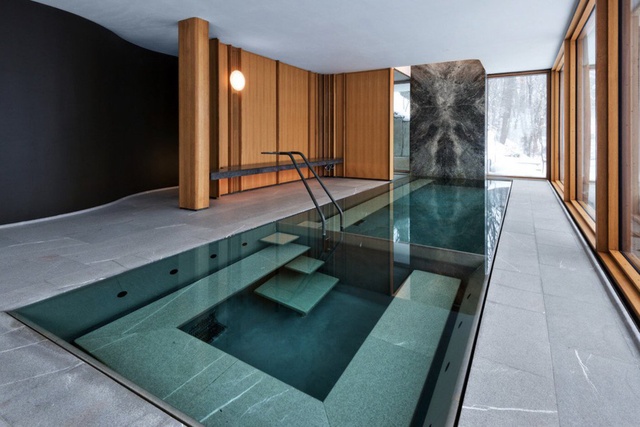
FM: Are there any architecture filmmakers you admired or you think influenced this work?
JC: I have been deeply influenced by the artist Mark Lewis who does these amazing and unreal continuous shots that go between camera and drone, indoors to out and back in, that are seamless and create a totally unreal but very real relationship to our surroundings. And, of course, Stanley Kubrick. I have been in love with his work since I was a kid. His work, especially in The Shining, has really influenced how I understand space, cinematically-speaking.
FM: The music in the soundtrack often seems to emulate building materials (sounds of glass or metal, or tense structures). Was this part of your and the composers’ approach?
JC: To be honest, I can’t recall exactly [what my brief to the composers was], but I remember wanting it to be haunting – not dark or sad but a kind of ethereal haunting, like sounds based in nature but made from humans.
The music is so deeply layered, starting off with reverberated sounds that were actually recorded in the space. They sit under the music and function as a bridge of sorts or foundation for the entire score. People seem to be very moved by the music.
Dan Goldman and Shaun Brodie are two incredibly talented musicians who understood immediately what we wanted for the score. They were in Los Angeles so we would do this back and forth where we cut a scene and send it to them and they would compose music for it and then send it to us for comment. It was a really terrific iterative process.

FM: There is a beautiful shift between an ethereal mood into a slightly more chaotic one (when James is in the spa pool), which fits the change in James’ health. How did this affect the production of the film itself?
JC: From diagnosis to death was just over a year, so it was really at the early stages of the filming. We just understood that we had to shoot everything we could and that time, obviously, was of the essence. I believe when Jim was diagnosed, the doctors gave him a 25 per cent chance of survival, so it was clear that death was a very real possibility. I asked Jim how we should proceed and he was very open to us following and documenting the process of dying as much as we thought was necessary, so we did this, quite closely.
FM: The house has now changed hands… do you think James’ legacy of philanthropy and allowing the space to be used for fundraising will continue?
JC: The new owners are very dedicated to the original programmatic aspects of Integral House. In fact, they also bought all the possessions along with the house to ensure a coherent record is maintained. There continue to be events at Integral House to help fundraise for various local and international charities and arts organisations.
Integral Man will be screening at the 13th International Documentary Edge Festival, which runs in Wellington 9 – 20 May and Auckland 23 May – 4 June. It is also showing at the Resene Architecture and Design Film Festival on now in Auckland and in various cities around the country in the coming weeks. See rialto.co.nz for full details and tickets.

!["I asked Jim [pictured here] how we should proceed [after his cancer diagnosis] and he was very open to us following and documenting the process of dying as much as we thought was necessary."](https://cdn.architecturenow.co.nz/site_media/media/cache/82/ff/82ff92be07a5672ab50dca4fe274483a.jpg)
